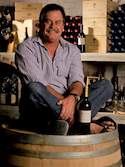It was through his fun-loving wife that Jacques Borman eventually realised his dream of making his own wine. Her father Reenen Furter, a radiologist from the Eastern Cape, had taken early retirement and gone sailing for six years with his wife Dalene. When he returned to find a place to 'settle down, space was a prerequisite and the idea of buying land for a wine farm held great appeal.

Jacques Borman knew the Polkadraai hills in Vlottenburg as a potentially good red wine site, having bought shiraz from a grower there in the 1990s while at La Motte.
It was a toss-up between two properties: the one had some vineyards and a house and farm buildings but not the best soils; the other had no infrastructure but deep, friable, moisture-retaining red clay soils on top of decomposed granite. They chose the latter.
'My father-in-law showed great faith in me and bought the property best for wine.'
Historically, the land had been part of the greater Spier estate, later sold off and partly planted to fruit. The existing vineyards were neglected.
'There was a bit of chardonnay and the rest was Clairette Blanche and granadillas!' Except for some cabernet sauvignon, 35 years old in 2012 and 'still producing some great wine!'
Remembering those first years at Boschkloof, Jacques describes it variously as him and his father-in-law 'working our butts off and 'working ourselves to death. In their first 1995/96 season, they cleaned up the vines worth keeping, pulled out the rest, put the whole farm under irrigation, built a winery and house and, made four wines under the Boschkloof label.
For Jacques, this was all done after hours. But the joy was that it was for themselves. 'If I had been working for someone else, I'd probably have had to pull out those old cabernet vines, for example, irrespective of quality, just because they'd have been considered unprofitable.'
Of the 30 hectares, some 17 hectares comprise mainly cabernet sauvignon, cabernet franc, merlot, shiraz, and chardonnay.
The vintner believes in making wine from his own fruit, to express the sight. 'When people drink Boschkloof they will hopefully start recognising it as such.
Ten, fifteen years ago you could be at a blind tasting and pick out wines from well-known estates: this one was distinctly Simonsberg, the other pure Helderberg. It's sad to see the loss of identity as the "estate" concept has fallen out of favour with winemakers buying in fruit from all over the Western Cape. Wines are becoming all the same.'
Jacques' quest for that mid-palate flavour concentration combined with elegance is evident in all his wines, perhaps never more so than in the Boschkloof Chardonnay. 'I enjoy chardonnay with a slightly limey character. I've never liked the very buttery, new-oak style.
This is why we use second- and third-fill barrels and just 10 percent new oak. Plus we add in some tank-fermented wine. We get our bit of butteriness from time on the lees rather than malolactic fermentation. Even the French are moving away from malo.'
 Chicken à la King recipe by Jacques Borman served with white rice and paired with Boschkloof Chardonnay wine....
Chicken à la King recipe by Jacques Borman served with white rice and paired with Boschkloof Chardonnay wine.... Curried lamb neck with fruit recipe by Jacques Borman paired with Boschkloof Syrah wine....
Curried lamb neck with fruit recipe by Jacques Borman paired with Boschkloof Syrah wine....